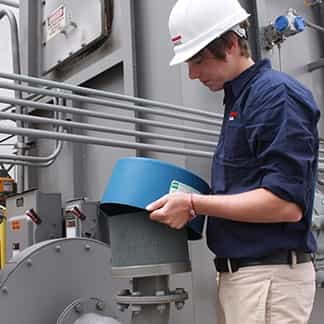This website uses cookies so that we can provide you with the best user experience possible. Cookie information is stored in your browser and performs functions such as recognising you when you return to our website and helping our team to understand which sections of the website you find most interesting and useful.
 The Challenge
The Challenge
OXIDIZER SERVICE SERIES: PART 4
As promised, this is the fourth installment of Anguil’s Oxidizer Service Series. If you have read through the first three parts, this can be seen as a capstone of those efforts. Having a strong oxidizer service plan, backed up with recommended spare parts and all of the proper documentation will not only improve your system performance but also allow you to focus on optimizing your oxidizer efficiency. Setting all of these aspects in place within your overall maintenance plan will help you become proactive in ensuring your system’s reliability. However, this does not take into account how much you are spending on a daily basis to operate. So, how much is your oxidizer costing you to operate? Do you know how much it should be costing you to run if it’s running efficiently? A fully optimized oxidizer will help you save money on operating costs, reduce your greenhouse gas footprint, and contribute to your bottom line in very measurable ways.
The Solution
Oxidizer system optimization can fall into two categories. The first is “reactive,” meaning you identify and respond to the small inefficiencies that may occur over the life of an oxidizer system. The second would be “proactive.” It is our goal that all of the tools we are providing you within this compilation allow you to act proactively, with the goal of you integrating these tools into your overall maintenance plan.
Things to Consider:
- Over the course of a year, unnecessarily treating an additional 1,000 SCFM (1,605 Nm3/hr) of process exhaust in an oxidizer system can cost upwards of $10,000 with an RTO and over $30,000 for a thermal recuperative system.
- Making a modest improvement in the Thermal Energy Recovery (TER) of an RTO system – even as little as 1% – can cut natural gas bills by 20% or more.
- Most emission abatement systems are designed and installed based on a theoretical projection of future production levels often with a safety factor included. If an oxidizer remains at a facility for 15 to 20 years as many do, it is very unlikely that an existing system is optimized for current production conditions, emission characteristics, and process demands.
It is also important to know that most emission abatement systems are designed and installed based on a theoretical projection of future production levels. If an oxidizer remains at a facility for 15-20 years, it is very unlikely that an existing system is optimized for current production conditions, emission characteristics, and process demands.
Plant managers owe it to themselves to periodically review the operating costs associated with their oxidizer system. This periodic review will allow for informed decisions about both reactive and proactive efforts, translating directly into lower operating costs. If PMEs or testing of the oxidizer is regularly required and included in your maintenance plan, this is an excellent time to schedule an operating cost review. Operating costs can be reviewed during monthly or even weekly walk-by inspections and checklists. These inspections are typically performed by your own personnel. However, Anguil can provide you with a checklist for Monthly Maintenance Day inspections of the system components needing inspection, independent verification, and/or calibration on a monthly basis. The more your maintenance team knows about your system and their capability to perform checks like this on their own, the more money you will save, and the more efficient your system will run.
 Optimization Strategies
Optimization Strategies
What follows are some general strategies for oxidizer optimization, applicable to a wide-range of system types. With limited historical information, an oxidizer company like Anguil can quickly determine which of the following strategies could be a good fit for you.
KNOW HOW MUCH YOUR OXIDIZER IS SUPPOSED TO BE COSTING YOU TO OPERATE
Make sure you can answer the following questions:
- What is the expected annual operating cost of our oxidizer?
- How close is our actual operating cost to that expected value?
With relatively minimal inputs, oxidizer vendors can run a performance model and give you the expected operating cost range for your system.
PAY ATTENTION TO THE PERCENTAGES
After five years of operation, an RTO originally designed for 95% Thermal Energy Recover (TER) could easily slip to 93% TER. This might not sound like a big deal, but that decrease in TER actually equates to a 40% increase in natural gas consumption. Percentage points do accrue over the course of a year, so get to know the critical parameters to watch as your system ages.
KNOW YOUR EMISSION LOADING – ESPECIALLY THE AMPLITUDE AND DURATION OF PEAKS
Especially the amplitude and duration of peaks. The size of an oxidizer is almost always determined by the peak emission levels coming from an application, but it is the average emission loading that dictates operating costs. Estimates for future “worst case scenarios” are made in the design phase to ensure a system is not undersized. After a couple years of operation, examine your actual day-to-day production loading to make sure you are not operating an oxidizer designed to handle a theoretical peak loading which you would in fact never reach.
KNOW WHAT OXIDIZER SYSTEM WOULD BE SPECIFIED FOR YOUR PROCESS TODAY
Vapor combustion technologies have evolved over the years. Knowing what is specified for your application in today’s energy conscious market can illuminate cost effective upgrades to existing equipment. Alternatively, an entirely different oxidation technology may be specified for your application today, so knowing what is currently available can save you from sinking too much money into an outdated oxidizer system.
IMPROVE PRIMARY HEAT RECOVERY
Oxidizers are typically designed with internal heat recovery. Usually, hot purified gases leaving the combustion chamber are used to pre-heat the incoming solvent laden air stream, which is the primary heat recovery of an oxidizer system. Projects improving the primary heat recovery of an oxidizer system offer the quickest payback because they provide additional heat recovery at all times the oxidizer is in service. For example, a coating company increased the primary heat recovery in their RTO and the system is now self-sustaining, meaning no supplemental fuel is required during most operating conditions. This coating company increased the primary heat recovery in their RTO and the system is now self-sustaining.
CONSIDER SECONDARY HEAT RECOVERY
If improving primary heat recovery is not cost effective or oxidizer operating conditions do not allow it, secondary heat recovery may be the best option for conserving the heat input to an oxidizer system. Heat exchangers can be added to the exhaust stack of an existing oxidizer to capture excess stack heat in air, water, or even steam. There are a wide variety of low back-pressure designs that can be added to an oxidizer’s stack without requiring a replacement of the oxidizer system fan. See our Oxidizer Energy Recovery Options article for an in-depth look at this optimization strategy.
 FOCUS ON COMBUSTION AIR
FOCUS ON COMBUSTION AIR
Combustion air, in both your oxidizer system and process burners, is often overlooked as a potential area for operating cost savings. Making sure burners are tuned properly and only firing when necessary can make a big difference. With RTOs, there is an additional money saving opportunity to install flameless supplemental fuel injection (SFI) systems where combustion air is not needed at all. Also, retrofit options that utilize a heat exchanger to supply combustion air from the chamber or stack.
INVESTIGATE AN EMISSION CONCENTRATOR
Burning air is expensive. In fact, fuel usage for most thermal and catalytic oxidizers will decrease as emission levels increase. If a significant portion of the process air being treated is near ambient temperature with low levels of contaminants, an emission concentrator may be an optimization option for your facility. Often utilized on paint booths and floor sweeps, this technology is capable of absorbing emissions and converting them into a smaller, more fuel rich air stream that reduces the heat input required by a combustion device. Concentrators can increase the capacity of an oxidizer by a factor of eight to 25 when added upstream of an existing system.
KNOW WHAT GRANT MONEY IS AVAILABLE TO YOU
Energy reduction upgrades to existing equipment will have an associated capital cost. These expenses can often be supplemented with grant money from utility companies if there is a significant reduction in fuel usage and/or electrical consumption. Know what grant money is available to you, whom to contact, when, and how to apply. Anguil routinely partners with our customers to secure grant money on applicable projects. We have found the Database for State Incentives for Renewables & Efficiency (DSIRE) to be a great resource.
PROPERLY MAINTAIN EXISTING SYSTEMS
No matter how well an abatement system is designed and manufactured, it cannot continue to operate at high efficiency levels without maintenance. Small inefficiencies in system operation can lead to large operating expenditures over the course of a year. While a formal maintenance plan with checks and balances is ideal, it is often not feasible. However, as noted in part two of the Oxidizer Service Series on Crafting a Maintenance Plan, there are basic service guidelines which can help improve uptime, keep you in compliance and reduce operating costs. With today’s energy prices, a regular service schedule can pay for itself many times over.
The Result
Anguil has written extensively on oxidizer operating cost reduction strategies. For more in-depth information that is not included in these optimization suggestions, view the full version of Anguil’s Operating Cost Reduction Strategies.
This is the fourth and final installment in Anguil’s Oxidizer Service Series. We encourage you to also view Part 1: Better Maintenance Starts With Better Documentation, Part 2: Crafting Your Oxidizer Maintenance Plan and Part 3: Stocking Spare Parts for Your Oxidizer System.


